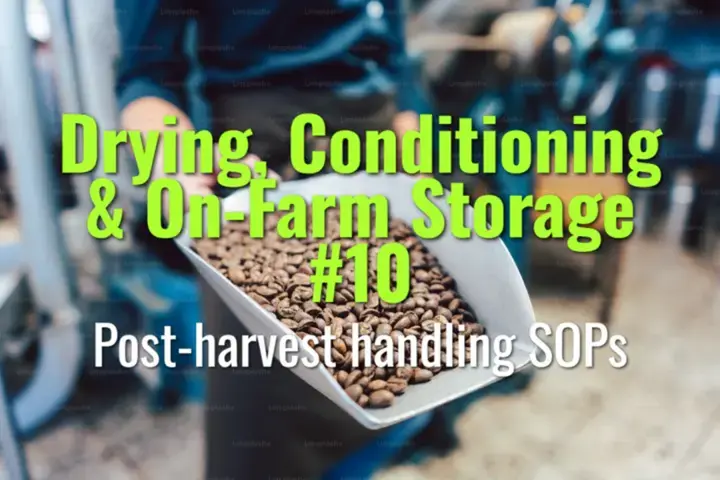Post-harvest handling SOPs
This topic explains the role of Standard Operating Procedures (SOPs) in post-harvest handling of coffee, outlining best practices for consistency, quality control, and traceability.
- Coffee Basics Nerds
- 2 min read
Article 10 of 12 in Drying, Conditioning & On-Farm Storage/

What Are SOPs?
- Standard Operating Procedures (SOPs) are documented step-by-step instructions that standardize post-harvest handling.
- They ensure all workers follow consistent methods, reducing errors and variability.
Why SOPs Matter in Coffee
- Post-harvest is where most quality can be lost.
- SOPs provide guidance, accountability, and repeatability.
- Buyers increasingly require documented handling protocols for transparency.
Core SOP Areas
1. Harvesting
- Pick only ripe cherries.
- Reject underripes, overripe, and visibly defective fruit.
2. Reception & Sorting
- Record lot details (farmer, variety, date).
- Perform flotation sorting to remove low-density cherries.
3. Processing
- Define exact steps for washed, natural, or honey methods.
- Include time, temperature, pH, and mucilage management.
4. Drying
- Specify bed thickness, turning frequency, and moisture targets.
- Include weather mitigation steps.
5. Conditioning & Storage
- Define resting period, warehouse climate, and pest control.
- Set monitoring intervals for moisture and water activity.
6. Quality Control & Cupping
- Establish checkpoints for sampling and defect screening.
- Record cupping scores and feedback for process improvement.
7. Documentation & Traceability
- Use logbooks or digital tools to track each step.
- Assign lot codes to ensure identity preservation.
Benefits of SOPs
- Consistency across harvests and workers.
- Improved quality and reduced defect rates.
- Compliance with certification and buyer requirements.
- Training tool for new workers and cooperatives.
Challenges
- Labor-intensive to train and enforce.
- Requires literacy and discipline in remote farm settings.
- Needs adaptation for different processing styles.
Lasting Importance
Post-harvest handling SOPs are a cornerstone of quality assurance in coffee. By documenting and standardizing every step from cherry to storage, producers safeguard quality, build buyer trust, and increase access to premium markets.
You might also like:
- Tags:
- Lasting Importance
- Quality Control
- Cupping Scores
- Water Activity
- Labor Intensive
- Lot Codes
- Post Harvest
- Step Step
- Quality Assurance
- Matter Coffee
- Turning Frequency
- Natural Honey
- Ripe Cherries
- Washed Natural
- Temperature Ph
- Moisture Water
- Low Density
- Buyer Trust
- Bed Thickness
- Challenges Labor
- Sorting Remove
- Pest Control
- Operating Procedures
- Standard Operating
- Flotation Sorting
- Require Documented
- Defect Rates
- Safeguard Quality